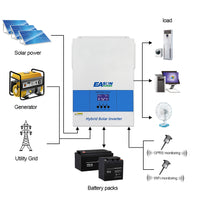When it comes to harnessing solar energy for industrial use, a user-friendly hybrid solar inverter is an essential component. In this ultimate guide, we will delve into the intricacies of setting up a hybrid solar inverter in an industrial setting, with a focus on ease of use and efficiency.

Understanding the Basics
Before diving into the setup process, it's crucial to have a solid understanding of what a hybrid solar inverter is and how it functions. A hybrid solar inverter is a device that manages the flow of electricity from both solar panels and the grid, allowing seamless switching between the two sources. This ensures a continuous and reliable power supply, making it an ideal choice for industrial applications where uninterrupted power is a necessity.
One of the key advantages of a user-friendly hybrid solar inverter is its intuitive interface, which simplifies the setup and monitoring process. With features such as plug-and-play connectivity and real-time performance data, industrial users can easily optimize their energy usage and maximize cost savings.
Choosing the Right System
Before embarking on the setup process, it's important to carefully assess the energy needs of the industrial facility and select a hybrid solar inverter system that aligns with those requirements. Factors such as the size of the facility, energy consumption patterns, and peak power demands should all be taken into consideration.
Furthermore, the chosen hybrid solar inverter should be compatible with the existing infrastructure and other renewable energy systems, such as wind turbines or battery storage. This seamless integration is essential for maximizing the overall efficiency and reliability of the industrial power system.
Installation and Configuration
Once the right hybrid solar inverter system has been selected, the next step is the installation and configuration process. This typically involves mounting the inverter in a suitable location, connecting it to the solar panels and the grid, and configuring the settings for optimal performance.
Thanks to advancements in technology, many user-friendly hybrid solar inverters now come with mobile app integration, allowing for remote monitoring and control. This means that industrial users can easily keep track of their energy production and consumption, as well as make adjustments to the system settings, all from the convenience of their mobile devices.
Maintenance and Optimization
Setting up a user-friendly hybrid solar inverter is just the beginning. To ensure long-term performance and reliability, regular maintenance and optimization are crucial. This includes routine inspections, cleaning of solar panels, and software updates for the inverter system.
Moreover, industrial users can take advantage of the advanced monitoring and analytics features offered by many hybrid solar inverters to identify potential areas for improvement and maximize energy efficiency. By leveraging these capabilities, industrial facilities can further reduce their carbon footprint and operating costs.
In conclusion, the setup of a user-friendly hybrid solar inverter in an industrial setting is a critical step towards achieving sustainable and cost-effective energy usage. By understanding the basics, choosing the right system, and implementing proper installation, configuration, maintenance, and optimization practices, industrial users can fully harness the power of solar energy while enjoying the convenience and efficiency offered by a user-friendly hybrid solar inverter.



